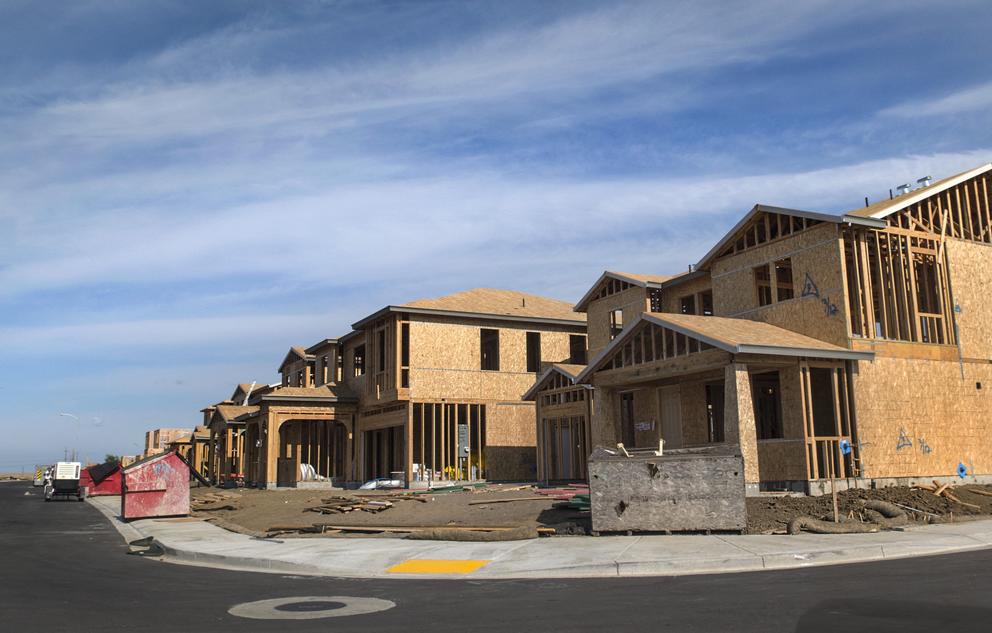State Rep. Liz Pike was hard at work, baking cookies. Ninety-eight cookies to be precise — one for each member of the Washington House of Representatives. The homemade treats were part of her bid to pass a bill she had been working on for years to allow more building under the state’s Growth Management Act. As a member of the minority Republican party in the House, she was pulling out all the stops.
It’s hard to say how much the cookies helped, but Pike’s bill passed both the House and Senate with more than a three-fourths majority. Despite that veto-proof vote margin, growth-management advocates are urging Gov. Jay Inslee to reject the measure.
Pike’s bill is one of four pieces of legislation to pass this year as a result of long-simmering complaints by rural areas about Washington’s 27-year-old Growth Management Act. Growth-management watchdogs say three of these measures are steps in the wrong direction. Yet Democrats largely went along with the concerns that traditionally have been embodied in Republican critiques of the law.
Issues involved include where schools can be built; when it’s OK to develop forestlands and farms alongside railroads; and allowing small rural counties to opt for promoting business over controlling growth.
Democrats calculated that goodwill from their support of these laws would win Republican support to change a provision in state law – a loophole, opponents say – that grants some developers extraordinary lenience in complying with modern zoning standards.
The Democrats were wrong. The Republicans refused to go along with eliminating the zoning loophole. Result: The Republican-backed growth measures passed, while the one sought most by Democrats did not.
As a group, the new measures “substantially weaken” the Growth Management Act, said Tim Trohimovich, director of planning and law for Futurewise, the state’s main growth-management watchdog group. He called 2017 a “bad year” for growth management.
Attempts to alter the Growth Management Act come up every year, filed both by Republicans seeking to help rural areas as well as Democrats to fine-tune the law’s attempts to balance growth with the need to contain urban sprawl.
Three bills are waiting for the governor to act on them. Inslee has already taken action on one, partially vetoing HB 1017, a bill governing where new schools can be built.
An old debate changes, slightly
The Growth Management Act is a complex law that lays out how the state deals with population increases, balancing 14 development-related goals, including historic preservation and reducing sprawl. The state population has grown by more than 30 percent since the law was passed in 1990, and not a lot about the law has changed.
Ask Democrats from urban areas, and they will likely say that the Growth Management Act has worked well and allows counties across the state to adapt as needed. But ask Republicans from a rural area, and they will likely tell a near-opposite story: The Growth Management Act is a one-size-fits-all approach that has limited economic growth in their communities..
Last year, no bills related to the Act passed, largely because the chair of the House Local Government Committee, where they were sent, did not give them a hearing. Rep. Sherry Appleton, a Democrat from Poulsbo who took over as chair in 2016, instead scheduled “work sessions” where legislators were ostensibly to learn more about the Act. She effectively shut down debate on growth management for the year.
But Appleton’s committee never got the chance to put what members learned from those work sessions to use this year. House leaders instead sent the bills to the House Environment Committee. House leaders are said to have attributed the decision to an imbalance in how many bills the two committees were hearing. But several lawmakers speculated it was because Appleton held up the bills in 2016.
“The powers that be, or the opposition, thought I was too hard-nosed,” Appleton said. She added, “I feel very strongly about the GMA. I think it was a promise to the people.”
House Environment Committee Chair Rep. Joe Fitzgibbon, a Democrat from Burien, thought working out a compromise on several Republican-backed measures on the Growth Management Act would buy Republicans’ acquiescence for his own growth management bill, HB 2023, which would close the building rights loophole that Democrats have been trying to close for years.
That approach backfired. The loophole closure didn’t happen.
“The Senate was really intransigent about the bill,” Fitzgibbon said. “I was really disappointed.”
His committee amended and passed three Republican-sponsored bills. Fitzgibbon and the majority of House Democrats who voted with him on those bills maintain that the measures do not weaken the law.
Futurewise doesn’t see it that way.
“It’s a pretty big deal when we start seeing the erosion of the GMA,” said Bryce Yadon, state policy director for Futurewise. Yadon argues that while imperfect, the Act has been a success story: “We think it’s been wildly important and extremely successful in making this a desirable place to live.”
The organization’s stance means it opposes any bill that might affect the goals of the Growth Management Act. Which is why Futurewise asked Inslee to veto two of the bills.
Appleton agrees with Futurewise that this session’s bills have weakened the Growth Management Act.
“I’m disappointed,” Appleton said. “We don’t want sprawl. … There has to be some kind of protection.”
On the other side of argument is Art Castle, vice president of the Building Industry Association of Washington, who minimized the importance of the changes in the law.
“There really wasn’t much in the session that affected GMA,” he said.
Here’s a breakdown of bills related to the Growth Management Act:
HB 1017 has been partially signed into law. It allows building of new schools outside of designated urban growth areas. The Growth Management Act does not specifically mention schools, but local growth plans based on it effectively limit new school construction to urban areas as part of the goal of limiting sprawl. That’s because where the schools go, so go the people. Adding schools outside these areas increases traffic and commuting time, but it also often means creating new sewer lines, which can then be tapped into by new housing developments.
While it’s a recipe for the very urban sprawl that the state has been trying to avoid, school districts have increasingly had difficulty finding sites for new schools as populations grow. One-tenth of Washington school districts are in this predicament, some of them with immediate need of new schools, according to information gathered by the Bethel School District, one of the districts directly affected by the bill.
Though Futurewise requested a veto on the bill, Gov. Inslee signed it into law on Wednesday. He did give growth-management advocates a win, though, in vetoing a section that would allow extending new sewer lines to the schools. Inslee kept the sections that exempted the Bethel School District in Pierce County from regional planning constraints.
Tom Siegel, the superintendent of Bethel School District, says it solves the largest problems for his district, because it can build a septic system for the new high school it has planned.
“It’s as good as we can get right now,” Siegel says. But, he adds, there’s more work to be done.
Because schools that serve urban students aren’t supposed to be built outside urban areas, the law is unclear as to whether existing schools in rural areas can be expanded, even with portable classrooms.
“There needs to be clarity about what you can do with the currently existing rural schools. Can they be expanded or modified?” Siegel asked.
Inslee has asked the Legislature to use the special session to rework the section of the bill he vetoed to provider clearer criteria for when and how a school district can extend sewer lines to new schools.
HB 1504 arrived on the governor’s desk on April 23. He has 20 days to take action.
This is Rep. Pike’s bill (yes, the one she lobbied for using cookies), which allows land designated as agricultural or forest next to the state’s smaller railroads to be rezoned industrial if it is for a rail-dependent use, such as a furniture factory that would ship its product by rail. Washington has 22 so-called “shortline railroads” covering 1,346 miles, with much of it along agricultural and forest land. Pike said she knows of five companies that want to move to Clark County, where her district is located, and bring in thousands of jobs if they can get rail access.

An amendment to the bill limits its application to Eastern Washington and Clark County, but Futurewise says that isn’t enough. Most of the state’s agricultural land is in Eastern Washington, the group notes.
Clark County is in a unique situation. Many Clark County residents commute into Portland, just across the state line, to work. That deprives the county of tax revenue paid by local businesses. New businesses along the 33-mile rail line that diagonally cuts across the county will provide a much needed increase in local revenue to keep up with the population size, says Pike. And, she adds, it will even lower emissions, as shipping by rail is less greenhouse-gas intensive than by truck.
“Bringing these jobs is kind of a three-way win for our communities,” Rep. Pike said. “It brings local jobs so people don’t have to commute, creates a new tax revenue source and it takes away wear and tear off of our roads.”
Futurewise has requested a veto on this bill as well, arguing that it allows too much valuable forest and agricultural land to be paved over.
“Once you build on it you can’t get it back,” said Futurewise’s Yadon.
HB 1683 is also sitting on the governor’s desk, but faces no threat of veto. In fact, it passed unanimously. Proposed by Appleton, though it did not move through her committee, it allows properties that use septic systems to be excused from the state’s push to get all property connected to a sewer, as long as the property cannot be redeveloped, already has a non-polluting septic system and the septic system is periodically tested to ensure it is well maintained.
The use of septic systems across the state has long been a contentious issue. Uninspected systems can malfunction and pollute the water around them if not well maintained. Appleton’s bill requires testing of systems by a public agency and was the only bill that passed this year supported by Futurewise. Testing of septic systems has been a goal of environmentalists for years.
The bill is important for counties like Appleton’s, Kitsap, with low density and lots of hills, where building new sewers is especially costly.
HB 2023 was Rep. Fitzgibbon’s attempt to close a development loophole called vesting, but the bill never reached final passage. Under current law, developers can file permits for new development before a new law limiting development areas goes into effect, even if they don’t start construction for years. It creates a way around the urban growth boundaries that are periodically updated by cities and counties for developers, leaving a patchwork of development outside of designated urban areas.
Fitzgibbon’s bill sought to better protect agricultural and rural lands as well as critical habitat areas such as wetlands and steep slopes.
But the Senate was having none of it. It kept the structure of the bill, but effectively inverted it and made it harder to protect those same lands. The Senate passed the inverted bill and sent it back to the House, which refused to concur with the changes.
In the new special session the bill is still officially alive, but the uncompromising message sent by the Senate amendments was clear and it is unlikely to move further this year.
SB 5790 is still awaiting Inslee’s action. It allows small counties with populations below 75,000 to override part of the Growth Management Act if they meet the state’s criteria for being in “economic deterioration.” It would let them prioritize economic growth over environmental protection and sustainable development.
Democrats in the House passed the bill, hoping that in return the Senate would approve the zoning reform bill. But their gesture of good faith was not returned.
While the bill won’t affect a lot of counties, Trohimovich of Futurewise sees it as a big loss for the environment in rural counties. And an unnecessary one.
For his part, Inslee maintained at the signing of the school-siting bill that he still supports the Growth Management Act.
“If the Growth Management Act is to maintain its integrity – if we are going to get value out of that, which is to preserve some degree of rural character – then we can’t allow it to be death by a thousand cuts,” Inslee said.
Growth-management supporters will be watching carefully as Inslee decides about further measures.
This story is part of InvestigateWest’s Statehouse News Project, a crowdfunded effort to provide independent reporting on the Legislature. Please support the project with a tax-deductible donation at invw.org.


